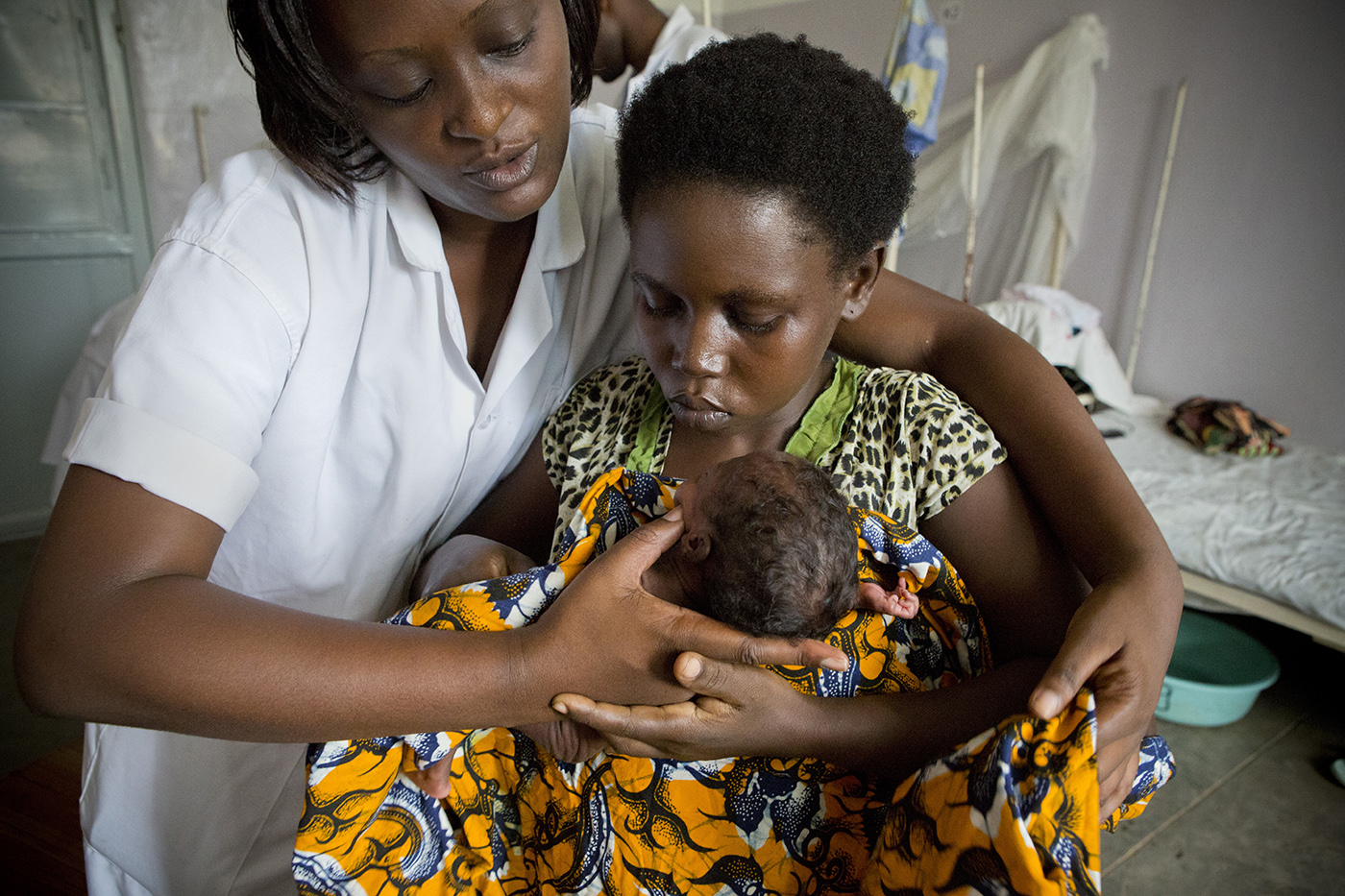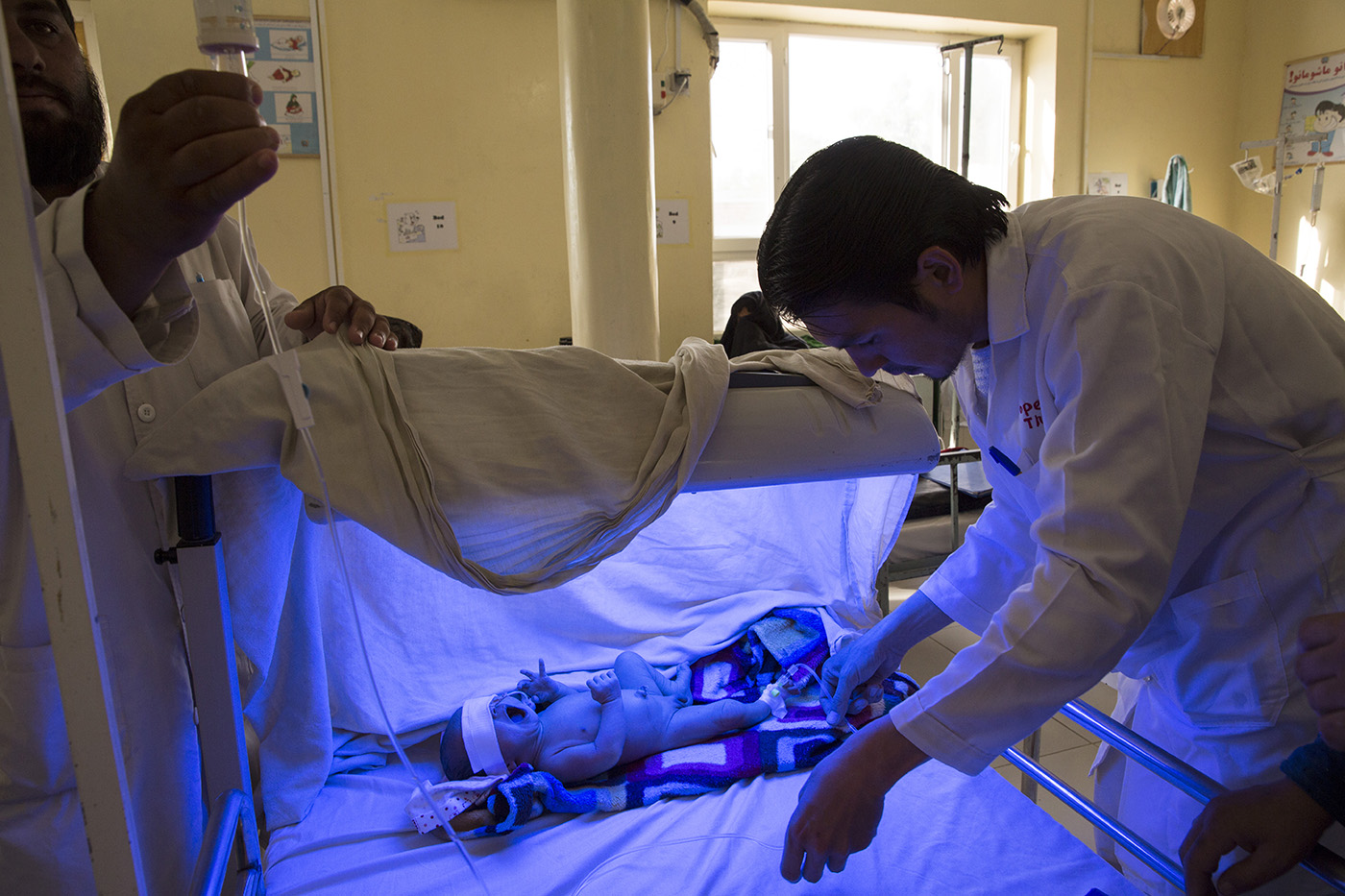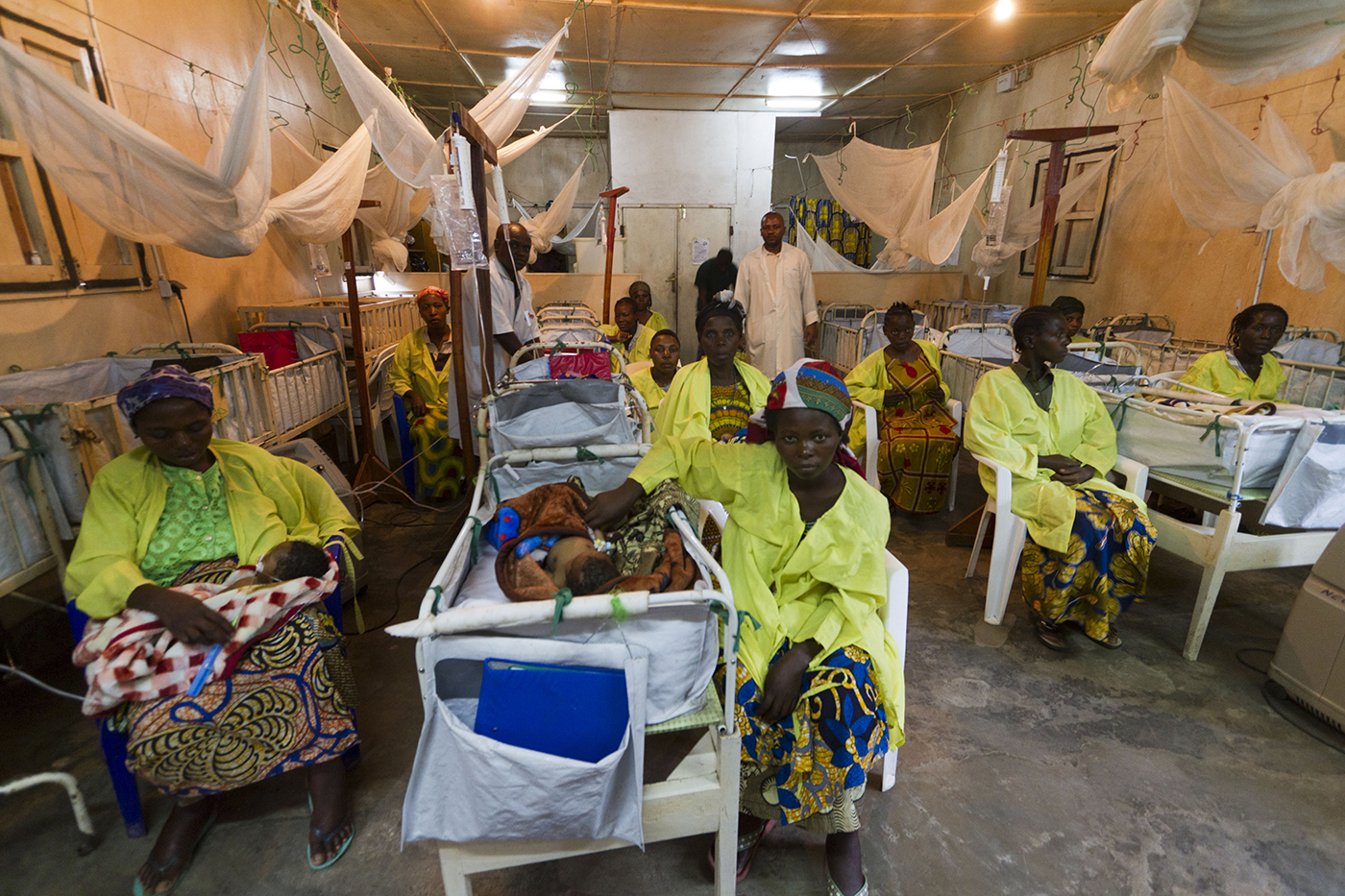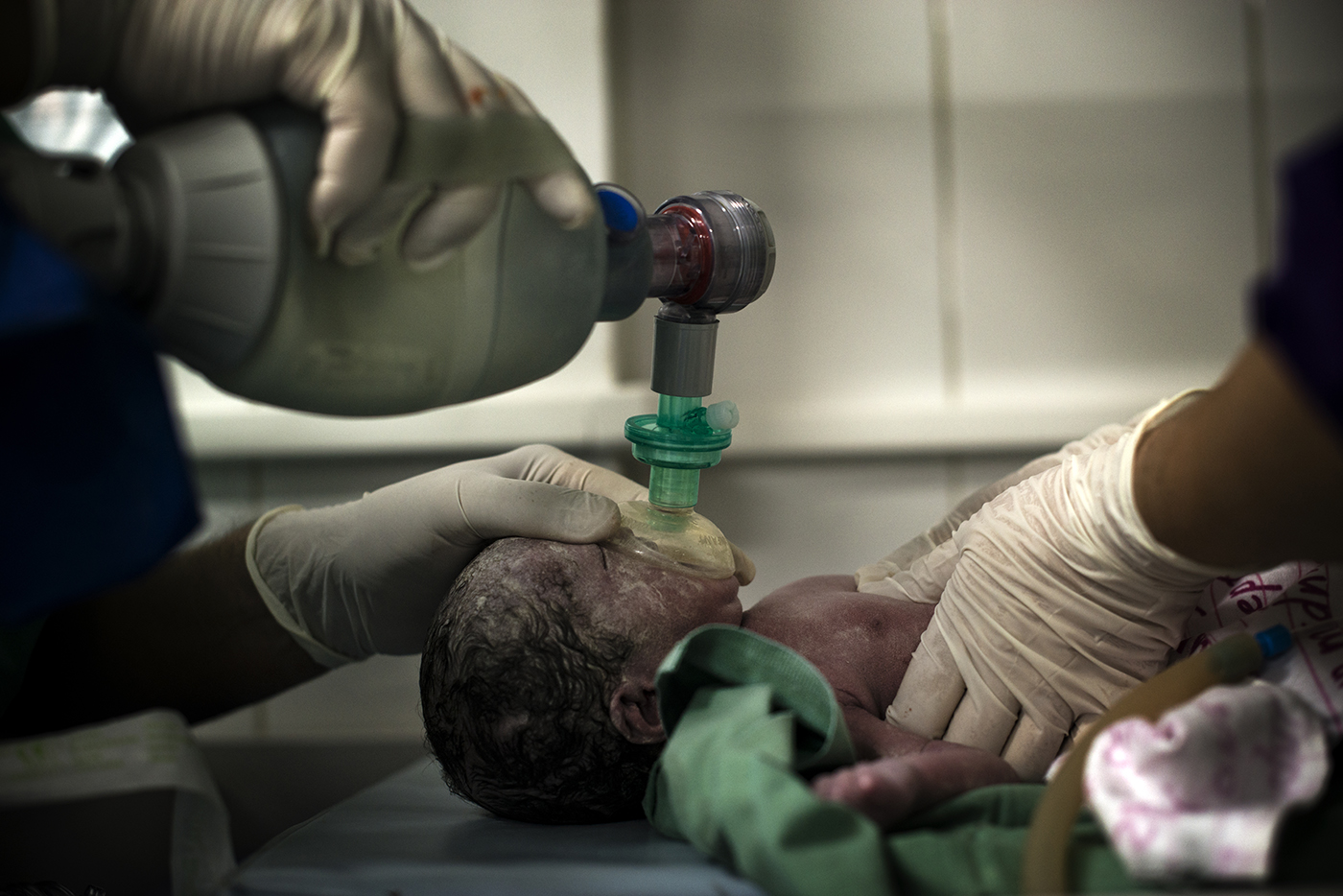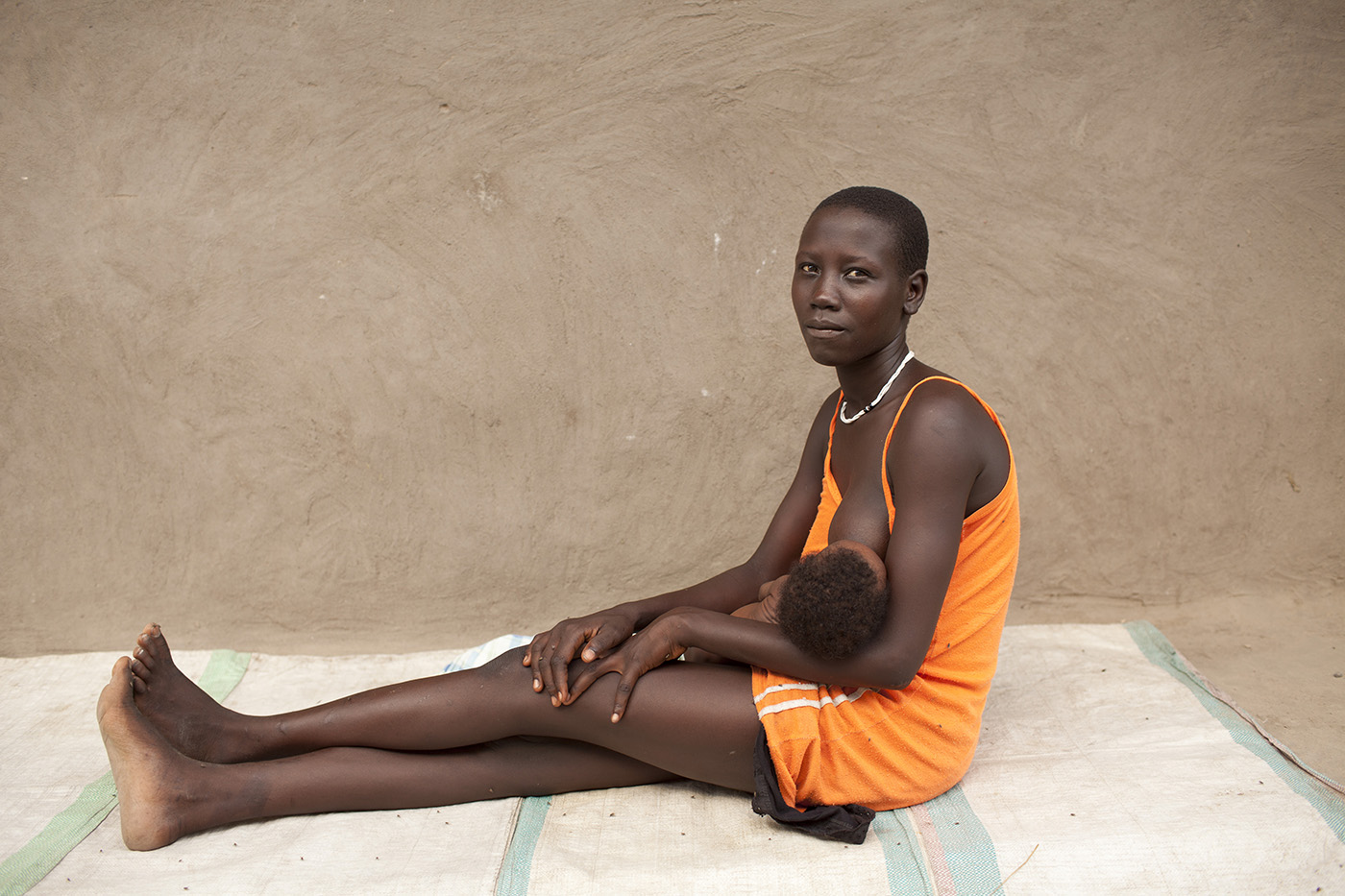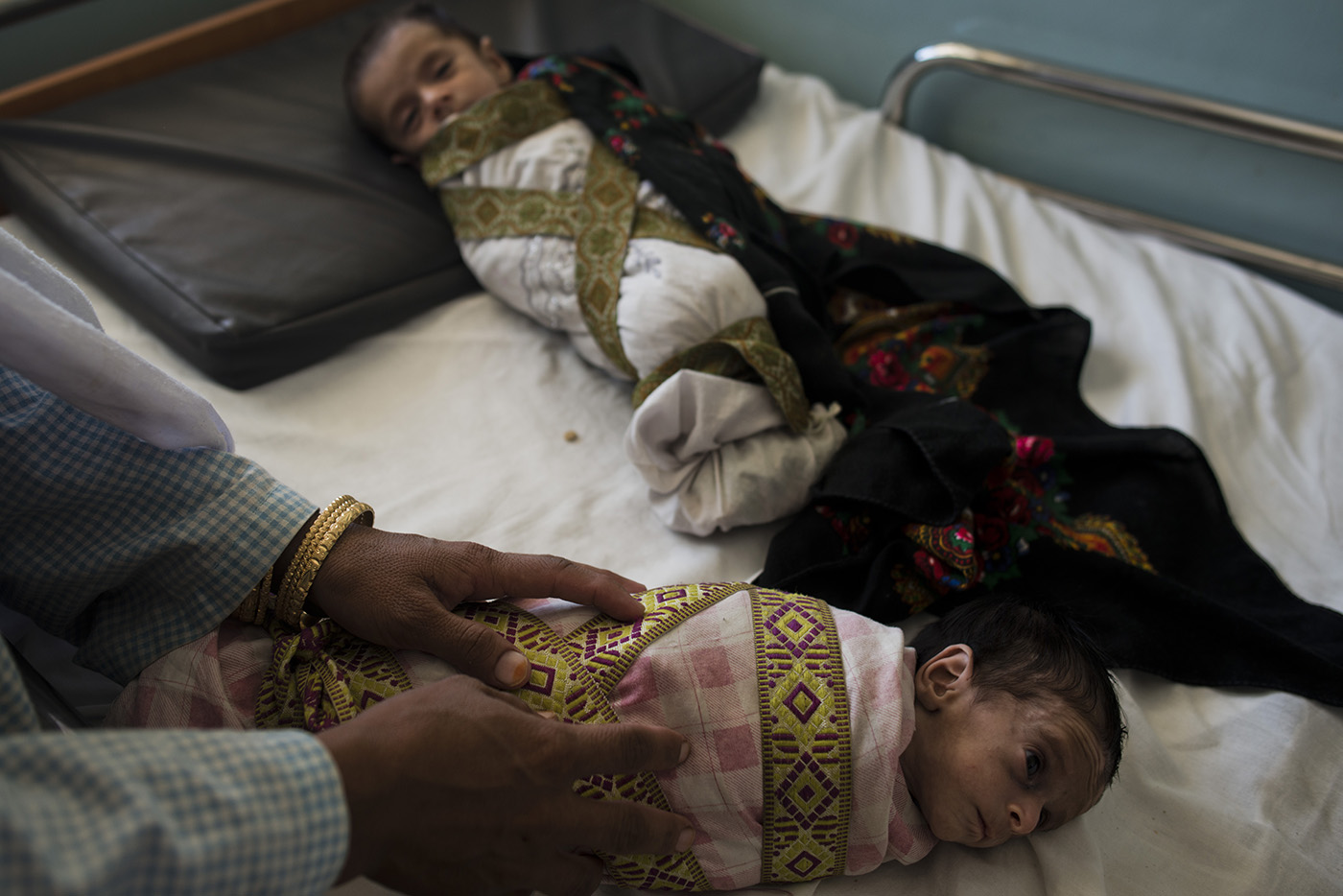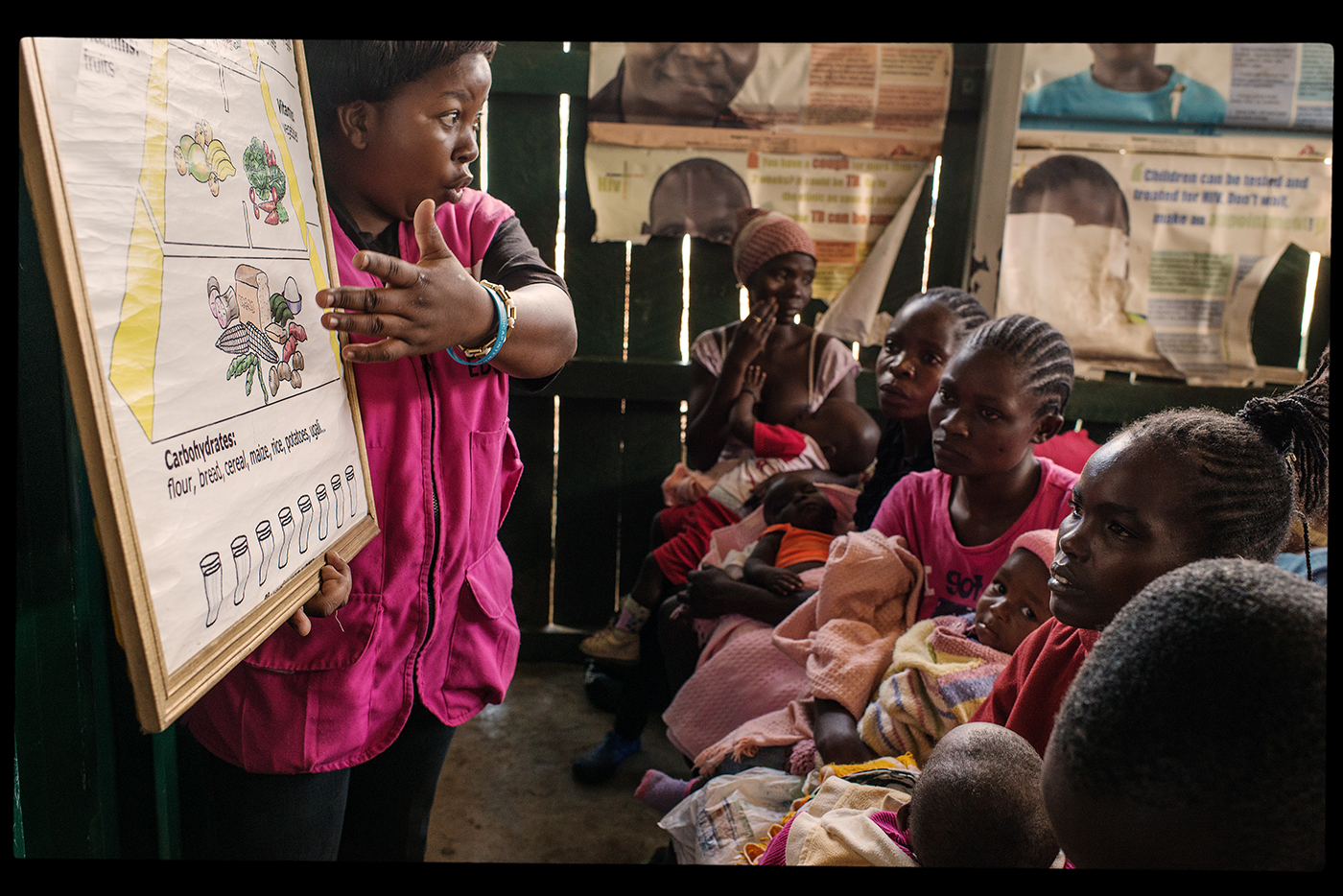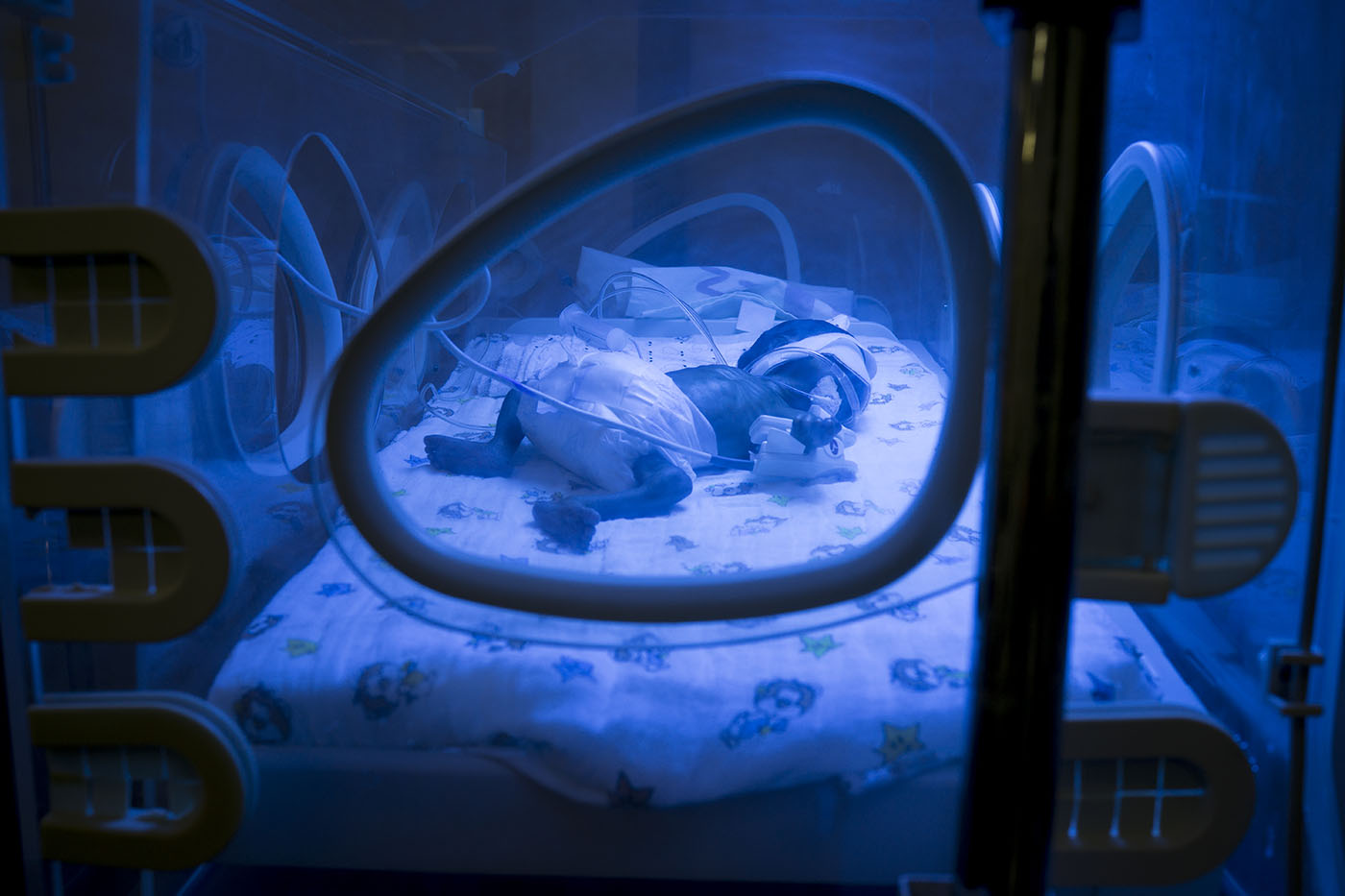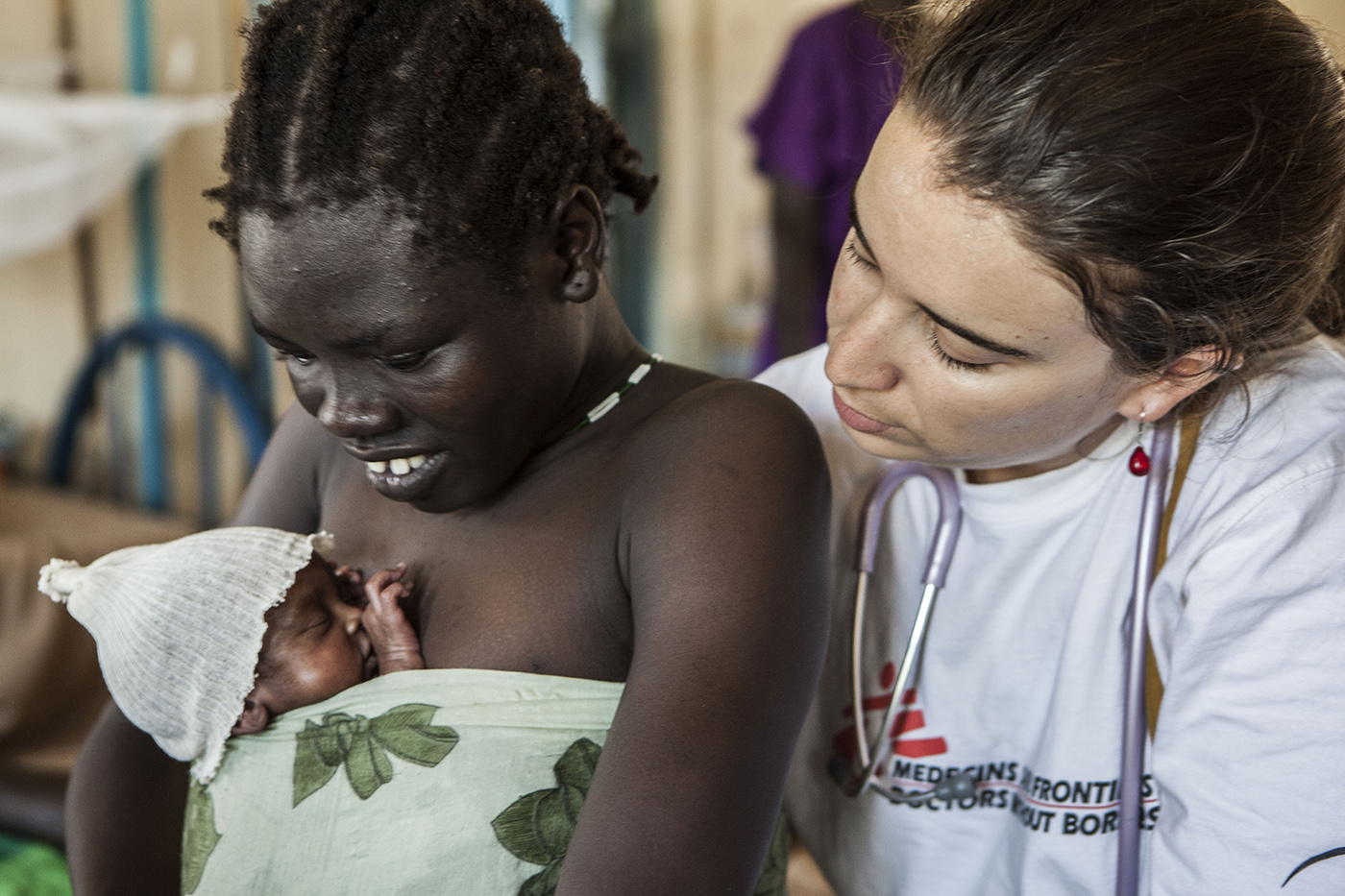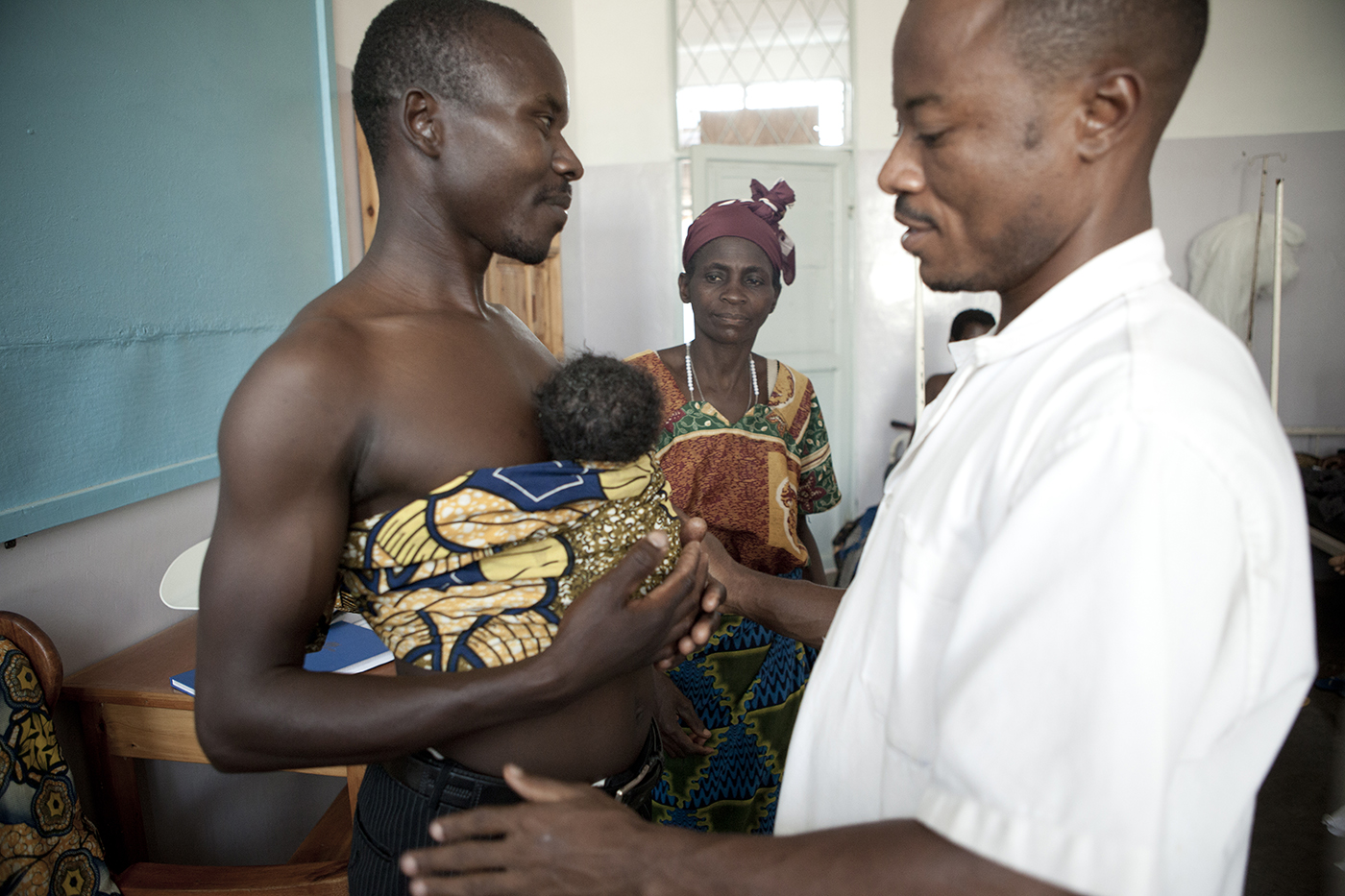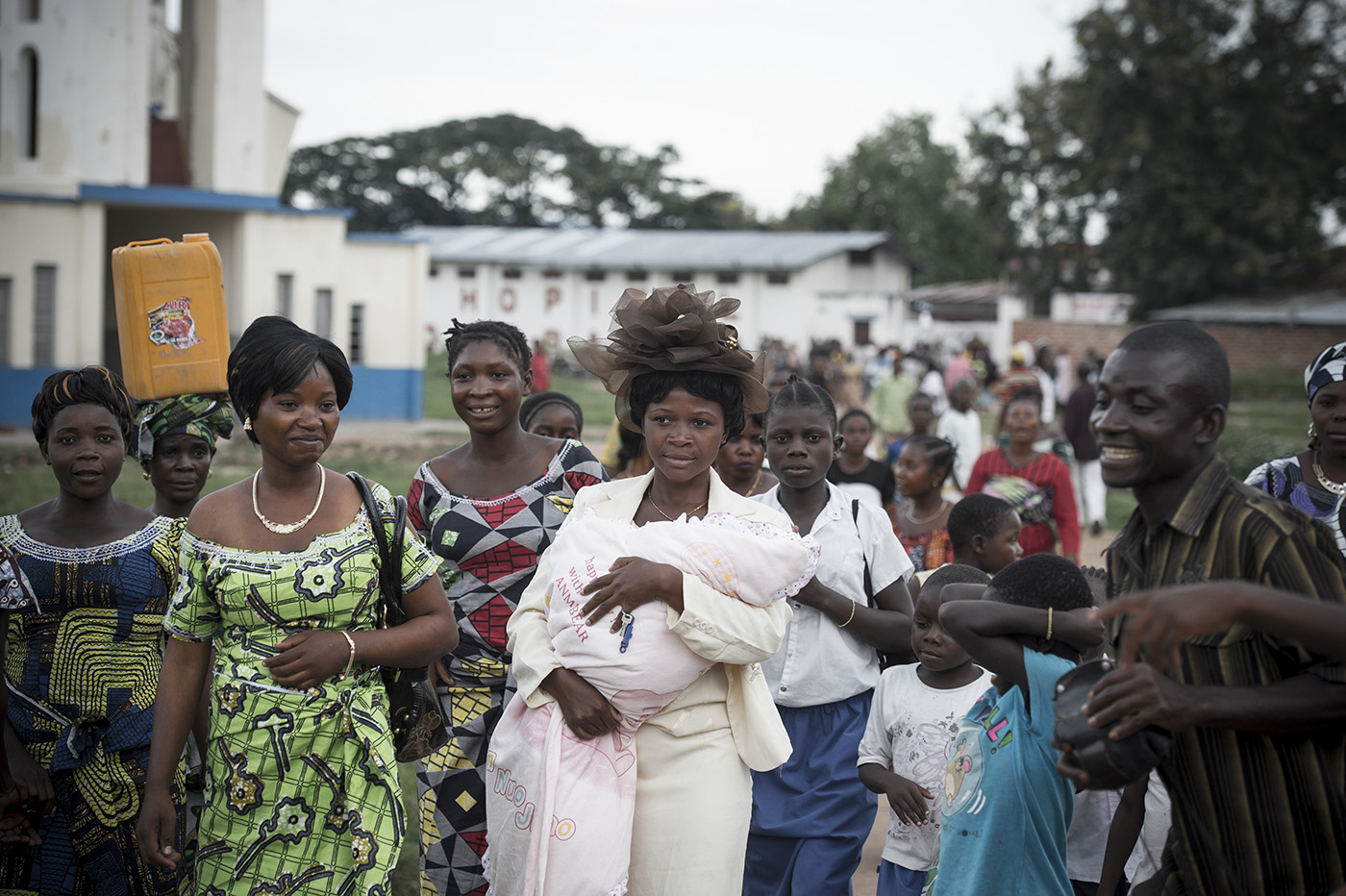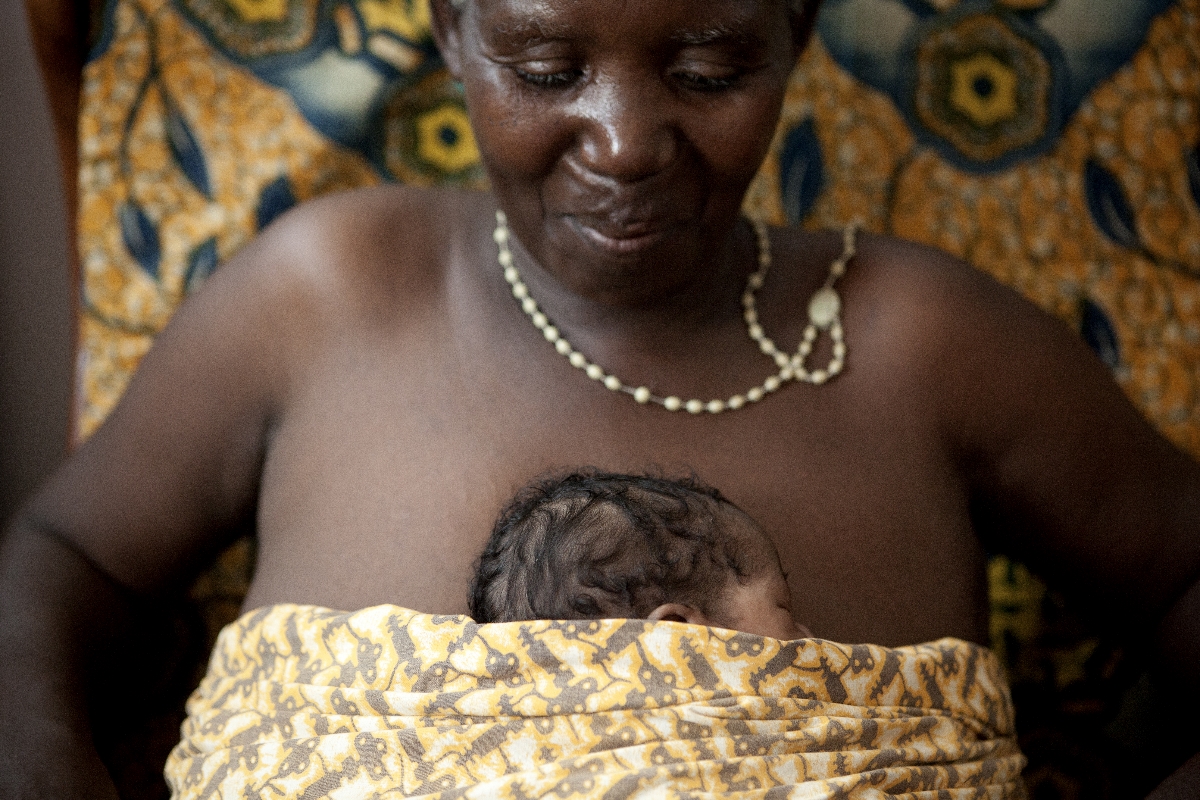
Breaking Down the Wall
Between Maternal
and Newborn Care
By Kristin Hooper, RN, BSN, with Dr. Nicolas Peyraud, MD

One day in 2013, Mary Abuk*, a beautiful 19-year-old, delivered triplets about 12 weeks prematurely in the MSF-supported hospital in Aweil, South Sudan. Two of the babies were stillborn, but one survived, a tiny little boy. He weighed only 900 grams (less than two pounds), and our staff set about doing everything they could to save him.
This child needed swift and effective care, something too often unavailable for mothers like Mary Abuk. Aweil sits in a region where medical care for newborns and their mothers—or medical care of any kind—has long been in short supply. Over time, many parents have grown resigned to losing children in the earliest stages of their lives. They are no less heartbroken, but many are reluctant to invest any hope in the possibility that a baby as underweight and frail as Mary Abuk’s son would make it through the day.
Mary Abuk, however, was determined to fight for her tiny son. She named him Deng Deng—“deng” means rain in the Dinka language—and she would stay with him in the hospital for the next two months.
MSF offers reproductive care in 159 projects worldwide.
In 2013, MSF teams delivered 182,234 babies.
In those early hours and days, the staff provided Deng Deng with all the standard elements of newborn care, keeping him in a warm room and making sure that Mary fed him every two to three hours with formula that we provided. The staff also administered IV fluids and antibiotics throughout the week.
With support from her own mother and guidance from the MSF team, Mary Abuk also performed “kangaroo care” for Deng Deng: the staff showed her how to wrap the baby close her chest, creating skin-to-skin contact that can help stabilize a baby’s temperature, encourage lactation in the mother, and enhance bonding between mother and child. She cleaned him and the linens that touched him every day. When she needed a rest, her mother would take over.
It wasn’t an easy process. Deng Deng, like all newborns, was highly susceptible to infections because while he was equipped with antibodies from his mother, his own immune system was not yet developed enough to fend off infectious threats. And the smaller and weaker a baby is, the harder it is for their body to build up immunity.
Over the next two months, Deng Deng’s health followed a pattern. He would get sick, then get better, then get sick again before recovering once more. Mary Abuk’s spirits rose and fell with his condition. She would be overjoyed that he was doing well, then devastated because she was sure he was going to die.
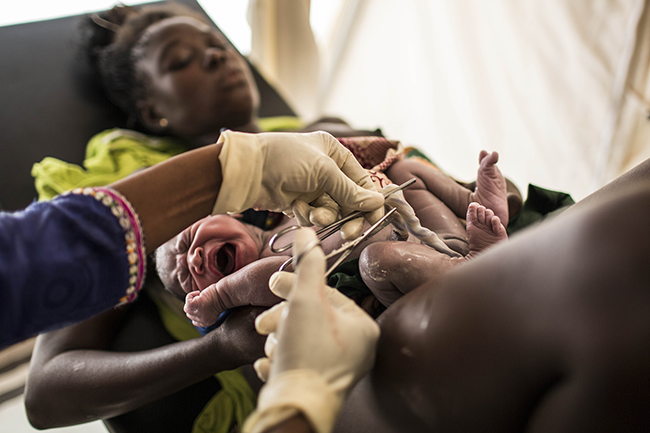
A midwife cuts the umbilical cord of a newborn baby in M’Poko camp, Central African
Republic. Photo by Laurence Geai
Deng Deng permanently lost his sight during this period, the sort of complication that is not uncommon to prematurely born babies fighting for their lives. But in the end, he put on weight. He grew. He got stronger. Four months after he was born, Mary Abuk brought him in for a check-up, and where we once saw a tiny baby on the brink of death, we now saw a healthy little boy.
It was heartening for our whole team. Beyond that, though, it was a good example of what can be done in an under-resourced country to keep a sick newborn alive when staff know what to do and they work together with the mother to do it.
Of the 6.6 million children under five years who died in 2012,
more than 2.9 million died within 28 days of birth.ii
There are many babies like Deng Deng who never get the chance to survive because they and their mothers have no access to proper care. It might be due to a region’s history of war or its lack of development. It might be that the import of newborn and maternal care is not well understood by the community or by some health workers. It might be some other factor.
Whatever the reasons, the lack of adequate newborn care in developing countries is a problem the international community has only recently begun to address in a serious way. While there has been an overall improvement in mortality of children under five—the number of child deaths dropped by about half between 1990 and 2013, according to a UN/World Bank report—other measurements of infant and neonatal death have not improved nearly as dramatically. In 1990, newborn deaths accounted for 37 percent of all under-five child deaths; in 2013, they accounted for 44 percent.i
In 2000, the UN laid out its Millennium Development Goal 4: to reduce the mortality rate of children under five by two-thirds by 2015. As of early 2015, this goal was not yet been reached, and if more attention isn’t paid to providing prompt and effective medical care for newborns, it may never be.iii
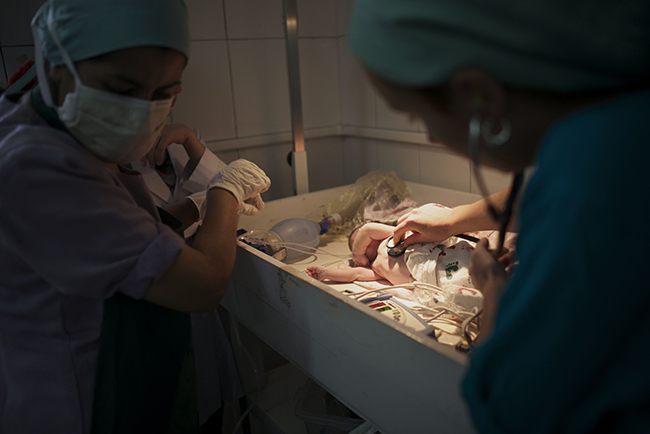
In Kabul, Afghanistan, midwives check the health of a newborn baby at the Ahmed Shah Baba Hospital. Photo by Andrea Bruce/Noor Images
A child’s health is most at risk in the first 28 days of life, the neonatal period. Put simply, all babies should receive basic newborn care. And neonatal care should be integrated with maternal care, meaning the staff treating mothers should be able to treat their newborns as well.
The health of the mother and the child are inextricably linked: the sort of care that most benefits newborns involves the mothers, and it should be sought out and offered before, during, and after the birth of the child. It may not require cutting-edge technology, but it does require diligence, attention, and skilled attendants.
It also requires an understanding that obstetric, antenatal, and postnatal care are not separate processes, but interconnected, all part of the effort to assist a mother through the birth process and protect her newborn from the threats a baby will inherently face upon entry into the world.
As the story of Mary Abuk and Deng Deng shows, there are certain steps and procedures that can save lives, even in places where resources are minimal. The majority of newborn deaths can in fact be prevented without sophisticated equipment or complex protocols. This is what MSF is trying to focus on.
“I brought my five-month-old baby here to the hospital five days ago because she has been having fever and diarrhea. I have three sons and four daughters. All of them I delivered at home, assisted by my mother or sister.
This baby always cried. I took her to see the mullah. The mullah said she was fine but she was still crying. My sister-in-law lives in Ahmad Shah Baba and she knew MSF worked here with some foreign doctors and provided good quality care, so I came here. The doctor said the baby was malnourished and he asked me to stay here with her for two weeks so she could recover. I stayed, but I’ve been worried about my other children at home.
Two of my sons died when they were very small. One died when he was five months old and one when he was just 10 days. They had fever and diarrhea. We didn’t know what was wrong with them. When we took the five-month-old to another public hospital in Kabul, the doctor said it was too late. He died in the hospital.
There is no private doctor or government clinic in our village. The closest place we can go is to the bazar in Kapisa, 30 minutes by foot. It took us three hours to arrive here by car. The road is not good.
We don’t always go to see a doctor when we are sick. Sometimes there is a conflict between the armed opposition and the government. There have been shootings in the village.
Sometimes we don’t have the money to pay for medical care. Then we just stay home and rest. We borrowed money from people in the village for transport to come here, 7000 afghanis [$121].
My husband works as a shopkeeper. We are poor. We don’t have money. Usually we pay 600 afghanis [$10] to see a private doctor in Kapisa and another 50-150 afghanis [$0.87 to $2.60] for the medicines. I am glad that Ahmad Shah Baba hospital is free of charge.
The women in our village all deliver at home. If they have complications, they go to Kapisa, but the doctors are not good. I heard some women died during delivery. Sometimes babies have died. There are a lot of stories like these.”
When a mother gives birth in an MSF facility, the midwife or nurse examines the baby and advises the mother to stay for monitoring of both her and her baby. Ideally, they would stay for the baby’s first 24 hours of life, though that often does not happen. With pre-term babies like Deng Deng (and full-term but underweight babies) the need to remain at the facility is crucial. These babies are at higher risk of dying in the first days of life, and the staff needs to keep a close watch for the most common killers: asphyxia and sepsis (an invasive, usually bacterial infection), and complications from prematurity.
For babies born outside of an MSF facility in an unhygienic environment, staff also look for tetanus, a disease caused by exposure to a deadly bacteria that is particularly dangerous for newborns. This is also a time when staff can provide counseling, treatment, and vaccinations that a mother may have missed if she did not receive antenatal care (ANC).
After birth and for the following days and weeks, MSF provides post-natal care, or PNC. In the best case, a mother will come in with her baby at least twice in the first six weeks for check-ups and necessary vaccinations and treatments [See Chapter 2: Maternal Health Before and After Childbirth].
Knowing the steps we have to take for newborns and their mothers is one thing. Implementing them in some of the places where we work is something else. When you look at the contexts in which many newborns die, you can see that this does not happen in a vacuum, nor is it because of mothers’ indifference.
Not only were there very few medical facilities
or trained staff available in the area, but they had not benefitted
from the transmission of knowledge about pregnancy and birth
that their mothers would have possessed, given their own experiences.
Deng Deng, for instance, was born into one of the world’s most challenging environments for newborns. His mother is part of a generation of men and women who grew up well before South Sudan was a country, during the protracted, bloody conflict between the Sudanese government and the Sudanese Peoples’ Liberation Movement. The civil war lasted for two decades, and by the time the two sides agreed to a truce in 2005, it had killed a million and a half people, displaced four million more, and crippled the development of education and public health systems throughout the South.
Many of the women who came to the MSF hospital in Aweil told me that they had lost or been separated from their parents and other relatives during the civil war. Many were married very young and moved away from their families. So not only were there very few medical facilities or trained staff available in the area, but they had not benefitted from the transmission of knowledge about pregnancy and birth that their mothers would have possessed, given their own experiences.
As such, there were many misconceptions among women from the area, some of which were potentially dangerous. In Aweil and elsewhere in South Sudan, this knowledge vacuum is an often overlooked consequence of the civil war. (Our staff also sees the same dynamics at play in other countries with the highest neonatal mortality rates.)
“I did not even know I had twins in me. When I arrived at the MSF clinic, I was well received and taken to the labor ward. I was in labor for a few hours and it was time to deliver. My first twin came out all right but the second one got stuck inside me. How I wished I had come for regular visits at the clinic because this problem could have been identified much earlier.
Because I did not have the money for a Caesarean section, I was scared about what would happen. MSF was able to provide for the surgical procedures I had to undergo as well as the after-care. I could not otherwise have afforded these trips or the treatment. At this hospital, I went through a Caesarean birth for my first time ever.
There were complications and by the time I left the hospital I had had four surgeries. I felt weak, sick and in pain. My children were underweight. Each weighed 1.6 kilograms. I was shocked—all my other children had been okay. My twins were put in an incubator for two weeks.
In my condition after the surgeries, the Government of Kenya social services intervened and took my twins to a children’s home—I could not take care of them. They are now seven months old, and I have been able to save some money to go see them once. I am hoping I will work hard and be in a better financial position to take them back, though I am happy that I received such help when I was not in a position to protect and provide for them.
I am just very grateful that I am alive and so are my children. I have seen many women here in the slums lose their babies during deliveries or after, and sometimes when they are a little older they die of malaria and hygiene-related diseases.
Kibera is a poor neighborhood. In such an environment, I make sure I am clean enough and try to feed my family a balanced diet when I have the money. Cleanliness is difficult though.
Hygiene starts with water, and we have to buy water and food and this becomes a challenge. I do not have a job and I rely on washing people’s clothes to make a living for myself and my children, so whatever I get, I have to spend wisely, knowing I might not get work tomorrow. This is very stressful and difficult especially as I am raising my children alone.”
MSF began neonatal care activities in Aweil hospital in 2008. Two years later, in response to the high rates of neonatal mortality in the area, the team created a separate neonatal care unit. It took some time to get everything working as it should in order to provide consistent, quality care.
Staffing was a particular difficulty, again due to the tolls of the civil war. Finding qualified health staff in a place where a whole generation was barely able to go to school continues to be an issue, but our teams were able to find people who could be taught what they needed to know. It’s not only the local staff who need to be readied to work in this environment, though. Foreign-born midwives and OBGYNs must also be briefed on the scope and nature of their responsibilities in the field, which often go far beyond what they’d be doing at home.
The numbers in Aweil show what’s possible when integrated maternal and neonatal protocols are combined with dedicated staff training. From 2011 to 2014, neonatal mortality inside the hospital dropped from 18.9 percent to 11.1 percent, while deliveries rose from 292 per month to 423 during the same period.
The progress does not lessen the challenges, however. The staff sees this every day.
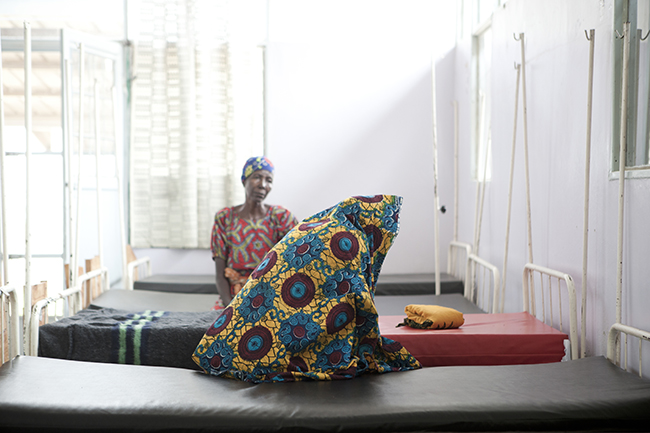
A 17-year-old mother in Kabezi, Burundi, cries after losing her baby, no more than one day old, to consequences of severe asphyxia during delivery. Photo by Martina Bacigalupo
One morning, a young woman I’ll call Sarah came in with four-day-old twins, a boy and a girl she had delivered at home. They were low birth weight babies likely born several weeks premature, and she was struggling to find the time to give them the attention they needed because she had other children at home who also needed tending to. She nonetheless had brought them into the hospital when they started to look sickly.
It was too late for the little boy, who died soon after his mother arrived. The little girl was febrile, malnourished, and was having trouble breathing. She was also symptomatic for sepsis and needed treatment immediately, so the staff started her on IV fluids and antibiotics. Sarah, however, believed that her son had died because she brought him to the hospital, that it was the hospital itself, in essence, that killed him. So she took her daughter home, refusing further treatment. We could not force her to stay, but it seemed very unlikely that the little girl would survive without the care we could offer.
It feels odd to call an instance when only one twin survived
a success story, but in this context it was.
For generations, long before MSF arrived on the scene, people in and around Aweil went to traditional healers for medical care. This is the case in many countries where MSF works and Sarah went to one with her daughter after leaving our hospital. Luckily for all, the healer she visited knew the limits of his abilities. He advised Sarah to come back to us and our facility, so we could treat her little girl. A few days later, she returned.
The main issue in Sarah’s case was that she simply did not know that she needed to feed her babies at night. Babies’ stomachs are very small and they can’t hold enough food to last eight hours. They need to be fed constantly.
Feeding can be its own issue, however. Breastfeeding is the best way to nourish a baby and a mother’s milk helps the child build immunity against diseases. It contains antibodies and other agents that can prevent diarrhea, which can cause a baby to become dangerously underweight. This, too, needs to be explained in many cases, and some mothers need to be convinced that it’s true. We heard some mothers say that the milk of a cow or a goat is better for a baby, when it decidedly is not.
“The situation [in Duékoué hospital, Ivory Coast, during the fighting in 2011] was chaotic at the beginning, as there had been so many other needs in the hospital. But women still give birth, conflict or not.
We knew we could implement some simple things that would help reduce the deaths of both mothers and newborns, the rate of which was enormous. My role was to help with the newborns.
The babies I saw dying in my first few weeks there were dying mainly of sepsis. They would get an infection, become pale, and then stop breathing. It was terrible to see all these babies dying.
When I arrived, we established a neonatal unit with standardized protocols, and we also encouraged exclusive breastfeeding, the sterilization of all the baby laundry, and the use of warm blankets. The mortality rate dropped drastically. It’s important to note that the rate stayed down—this wasn’t just a blip in the statistics.
Thanks to the Ivorian nurses’ aides, who embraced teaching the mothers how to breastfeed or how to use the breast pump if the babies were not attaching to the breast, we were able to achieve this.
The nurses’ aides would encourage mothers to use the breast pump six to eight times per day, and then the milk was fed to the babies by syringe. This was all recorded in a flowchart. With the nurses’ aides’ devotion to the job and the enormous task of feeding 15 to 20 babies by syringe every three hours for a 12-hour shift, many babies’ lives were saved.”
Even if they are convinced, some mothers simply could not produce enough breast milk. They were malnourished themselves, or not drinking enough water. These mothers needed treatment before they’d be capable of producing enough milk for their babies.
Once Sarah began to trust us and the care we were providing, she followed all of our instructions on hygiene and feeding. While our staff administered antibiotics and oxygen to the baby, Sarah fed her daughter through the night. She bathed her during morning bath time and washed her linens every day. Our staff trained her to use a breast-pump, which encourages lactation, too.
The little girl got better. When Sarah brought her back for her three-month check up, just before I left the project, she was a normal, healthy child.
It feels odd to call an instance when only one twin survived a success story, but in this context it was. Given the hardships that babies in Aweil face, we were thrilled every time a newborn recovered from potentially fatal circumstances and began exhibiting the signs we hoped to see. This was partly because we knew how many other stories don’t end as well.
Babies born early or small in under-resourced settings are particularly hard-pressed to get through their early days unscarred. Due to the fragile physiology of newborns, efforts to save their lives can damage their fragile ears or eyes and cause deafness or blindness—as in Deng Deng’s case. They are also susceptible to bleeding in their brains. Staff have to make choices based on the resources at their disposal, and after saving the mother’s life (because without their mother, her other children are far more likely to die), the foremost priority is saving a newborn’s life.
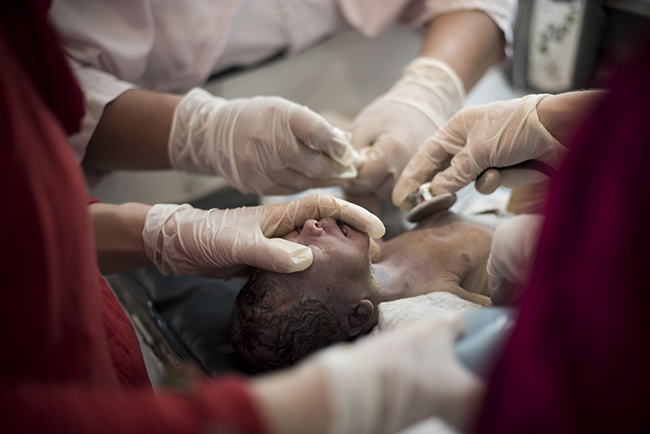
Midwives try to save a baby born with complications at MSF’s maternity hospital in
Khost, Afghanistan. Photo by Andrea Bruce/Noor Images
There was a positive outcome for Sarah’s daughter after her mother learned what her baby needed and provided it. The baby also survived because our staff at the hospital, while not neonatal specialists, were well trained and knew what to do for a sick newborn. This underscores how important it is for MSF to prepare, through continual training, the people working in its programs for the realities of what they are going to face, even if it’s outside the realm of their previous experience.
In Aweil and other MSF facilities, midwives have first contact with the baby. They must assess the baby’s breathing and if need be, start resuscitation and call for assistance. Midwives are also trained to check for hypoglycemia, hypothermia, and sepsis and to treat these complications if they arise. Nurses and nurse aides in Aweil were trained to advise mothers about feeding and how to use a breast pump if necessary to give milk on a regular basis. These are skills that may well fall outside the core training midwives, doctors, OBGYNs, nurses, and aides have had, skills they must learn. It’s a function of necessity: in under-resourced areas neonatal units are rare, so staff need to be ready to go beyond the strict parameters of their profession. Midwives, for example, also need to learn to monitor and treat newborns for longer than a few hours after birth, and staff treating mothers post-partum should be trained in neonatal care as well.
And it’s not just the skills; a certain attitude is needed to work in environments like these. Staff need to be ready to work with tiny little beings that seem extremely delicate. They must be comfortable working in situations where the stakes are, quite literally, life and death.
In our training in Aweil, we repeated the same things
over and over and over again, drilling into our staff a set of simple,
clear-cut protocols they should follow in every situation.
In our training in Aweil, we repeated the same things over and over and over again, drilling into our staff a set of simple, clear-cut protocols they should follow in every situation—if a baby is not breathing, for instance, or if a baby is hypothermic. MSF projects don’t have the supplies, the equipment or the space of neonatal units in Paris, Tokyo, or New York, but our teams can still provide high-quality care by being consistent, thorough, and observant.
A real life example: in 2013, a young mother brought in two-day-old Joseph, whom she had given birth to at home. It was the mother’s third pregnancy. Her first two babies had died and she was very worried it was about to happen again, especially because Joseph was not taking in much milk from her breast.
Our staff quickly saw that the baby was hypothermic and took him straight into our neonatal unit to warm him. The unit as a whole is kept very warm, but we have only one radiant warmer, which was occupied at the time by a preterm baby. We decided to switch the preterm baby to kangaroo care and put Joseph under the radiant warmer.
The nurse then inserted an IV line for him. Since hypoglycemia often follows hypothermia, we also tested his blood sugar level. It was low and we determined that he was in fact hypoglycemic. The staff had been trained to use the protocol for hypoglycemia and they immediately went into action.
Guidelines and protocols can make each stage and episode of treatment seem very linear, as if only one thing is happening at any given time, but that may not be the case. For example, the guidelines may say to test the blood sugar of a baby who weighs less than 5.5 pounds (2.5 kilograms) and administer intravenous fluids containing dextrose, a type of sugar. But there are times when a vein is difficult to locate, or, as with Joseph, the baby will have not one hypoglycemic episode but a series of them throughout the day and into the night. This is called rebounding. In these instances, the staff must figure out when they need to start over with the protocols and when they need to adapt.
Joseph was very sick. He needed to stay on antibiotics for several days, which was nerve-wracking for his mother. But he did recover, I’m happy to say. It was a challenge in a hospital with limited space, but we kept him as far away as possible from other babies in the unit so he didn’t spread his infection onwards.
At MSF’s project in Duékoué, Ivory Coast, our colleague found a novel solution to the same problem. She bought small plastic tubs to put the babies in, replacing the existing wooden boxes. To cover the babies they used sterile material from the operating theater instead of fabric the mothers brought in, which was not clean enough to limit the risk of infection.
After the staff in Duékoué implemented specific neonatal care protocols in 2012, the neonatal unit there saw a drop in newborn mortality even more dramatic than Aweil’s. MSF had begun providing emergency care at Duékoué hospital in 2011, responding to an outbreak of violence in the area. Before the neonatal unit was installed in the hospital, newborns were being cared for in the open with other children and 80 percent of them did not survive. After MSF installed a tiny but functional neonatal nursery, we saw that figure come down to around 50 percent. Then, when the team had been trained to show mothers how to use breast pumps, to make sure babies were fed every three hours, and to adapt the environment further to reduce the risk of infection passed from one baby to another, as well as other straightforward skills, neonatal mortality fell to around 23 percent.
There are still more challenges to address, but this shows how seemingly small changes made a big difference in Duékoué, saving many more lives.
These initiatives are ongoing in more and more projects as MSF continues to implement integrated maternal and newborn care. For example, in Domeez camp in Iraqi Kurdistan, where around 60,000 Syrian refugees are now living, MSF opened a maternity center in August 2014. It offers complete maternal and newborn care from ANC to postnatal consultations.
MSF believes that integrating maternal and newborn care and providing comprehensive service are the best ways to lower neonatal deaths and to give babies who survive a better chance at long-term health, while keeping their mothers alive and healthy. All MSF maternity staff members are therefore being trained to improve basic newborn care and provide mothers with the information they need to keep their babies alive and healthy. There are limitations to what MSF can do, but we have already seen in places like Aweil and Duékoué that simple solutions can go a long way to saving lives.
Patient names have been changed.
iUNICEF, WHO, World Bank, UN, Levels and Trends in Child Mortality 2013, World Health Organization, pg 1. 2014 http://www.who.int/maternal_child_adolescent/documents/levels_trends_child_mortality_2013/en/
iiUNICEF, WHO, World Bank, UN, Levels and Trends in Child Mortality 2013, World Health Organization, pg 1. 2014 http://www.who.int/maternal_child_adolescent/documents/levels_trends_child_mortality_2013/en/
iiiLiu et al. “Global, regional, and national causes of child mortality: an updated systematic analysis for 2010 with time trends since 2000,” The Lancet. June 9 2012. vol. 379, p. 2158-9. http://www.who.int/immunization/diseases/tetanus/lancet-2012-global-child-mortality.pdf



